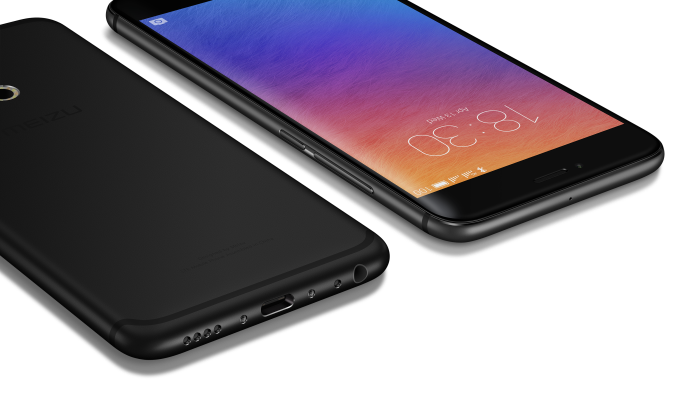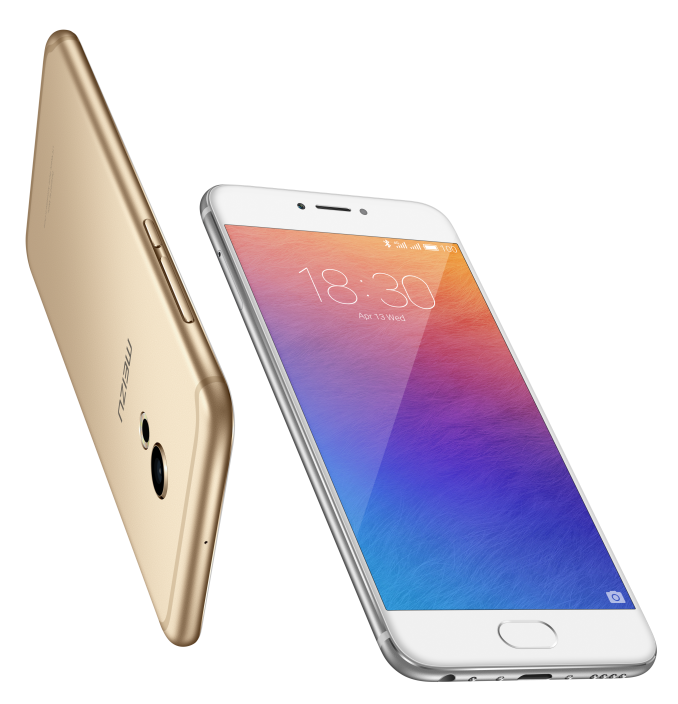Meizu Announces New PRO 6
by Andrei Frumusanu on April 13, 2016 5:30 AM EST- Posted in
- Smartphones
- Mobile
- Meizu
- PRO 6

Today Meizu launches the new PRO 6. The company had launched the PRO 5 only last September so this is a significant change in the release-schedule of the PRO series as we see the new unit come a mere 7 months after its predecessor. The "Pro" series initially debuted with the MX4Pro which we reviewed last year, since then Meizu has dropped the MX name to better differentiate between the "premium" PRO models and the more mainstream MX lineup. The PRO 6 in some ways continues where the PRO 5 left off, but at the same time makes some larger changes in terms of form-factor and component choices.
| Meizu PRO Series Specifications | ||
| Meizu PRO 6 | Meizu PRO 5 | |
| SoC | MediaTek Helio X25 2x A72 @ 2.5GHz 4x A53 @ 2.0GHz 4x A53 @ 1.4GHz Mali T880MP4 @ 850MHz |
Samsung Exynos 7420 4x A57 @ 2.1GHz 4x A53 @ 1.5GHz Mali T760MP8 @ 770MHz |
| RAM | 4GB LPDDR3-1866 | 3 / 4GB LPDDR4-3200 |
| NAND | 32 / 64GB eMMC 5.1 NAND | 32 / 64GB UFS 2.0 + microSD |
| Display | 5.2” 1080p AMOLED | 5.7” 1080p AMOLED |
| Modem | 2G/3G/4G LTE Cat 6 (Integrated MediaTek SoC Modem) |
2G/3G/4G LTE Cat 6 |
| Dimensions | 147.7 (h) x 70.8 (w) x 7.25 (d) mm 160g |
156.7 (h) x 78 (w) x 7.5 (d) mm 168g |
| Camera | Rear Camera 21.16MP ( 5444 x 4016 ) Sony IMX230 1/2.4" 1.12µm pixels F/2.2 aperture w/ Laser & Phase Detection focus |
Rear Camera 21.16MP ( 5444 x 4016 ) Sony IMX230 1/2.4" 1.12µm pixels F/2.0 aperture w/ Laser & Phase Detection focus w/ Dedicated Samsung ISP |
| Front Facing Camera 5MP 1.4µm pixels F/2.0 aperture |
Front Facing Camera 5MP 1.4µm pixels F/2.0 aperture |
|
| Battery | 2560mAh (~9.85 Whr) | 3050mAh (~11.74 Whr) |
| Launch OS | Android 6.0 with FlyMe 5.6 | Android 5.1 with FlyMe 5.0 |
| Connectivity | 802.11a/b/g/n 2.4 & 5GHz BT 4.1, GPS/GNSS USB-C 3.1 |
802.11 b/g/n/ac 2.4 & 5GHz BT 4.1 + BLE, GPS/GNSS USB-C |
| SIM Size | NanoSIM + NanoSIM | NanoSIM |
| Launch MSRP | 32GB RMB ¥2499 (USD~386, ~340€, ~271£) |
3GB/32GB RMB ¥2799 (USD~438, ~393€) |
| 64GB RMB ¥2799 (USD~432, ~381€, ~304£) |
4GB/64GB RMB ¥3099 (USD~485, ~435€) |
|
The PRO 6 is quite a strange successor as at first glance the upgrades aren't quite evident. The PRO 6 replaces the traditional Samsung LSI Exynos SoCs with MediaTek's Helio X25. The X25 is exclusive to the PRO 6 and essentially is an X20 with the dual-core A72 cluster clocked in at 2.5GHz instead of 2.3GHz. The three-cluster design also features a quad-core A53 at 2.0GHz as well as a low-power A53 quad-core at 1.4GHz. On the GPU side we see a Mali T880MP4 at 850MHz. Main memory is 4GB of LPDDR3 running at 933MHz.
The SoC choice puts the PRO 6 in a weird position when compared to the PRO 5 as except for single-thread performance the X25 should theoretically represent a downgrade compared to the Exynos 7420 in last year's model. It's especially in terms of power efficiency where this raises question as we move from a 14nm FinFET design back to a 20nm planar manufacturing process, so I hope that Meizu's SoC choice doesn't negatively impact power efficiency of the phone.
In terms of design the PRO 6 doesn't differ too much from the PRO 5, that is until one takes into account the form-factor of the new model. On the front we see very little distiguishable differences - except for the fact that Meizu downgraded the screen size from 5.7" down to 5.2" marking a departure from the larger "phablet" size. The display panel remains a 1080p AMOLED sourced by Samsung Display.
A first for Meizu is now the inclusion of a pressure sensitive touchscreen module which Meizu calls 3D Press. As we've seen in Apple's latest iPhones or even Huawei's implementation on the Mate S, this is a hardware feature that will undoubtedly depend on the software framework and applications to expose and take advantage of the new functionality. Meizu here might have some better lee-way in terms of Android customization when compared to other vendors who have to adhere to Google's CTS requirements, so it will be interesting to see what Meizu was able to come up with in the latest FlyMe 5.6 OS.
The reduction in size also has an impact on the integrated battery's capacity as we move from a 3050mAh cell down to a 2560mAh unit. Oddly enough, the device only loses 8g and remains relatively heavy for a 5.2" device, coming at 160g.
The main camera remains unchanged from the PRO 5, we find the same 21.16MP Sony IMX230 module featuring both PDAF as well as Laser auto-focus. We see a downgrade in the optics as the PRO 6 features an aperture of F/2.2 compared to the PRO 5's F/2.0 lens. The front-facing camera remains a 5MP unit with 1.4µm pixels.
The PRO 6 comes in 32GB or 64GB models RMB ¥2499 (USD~386, ~340€, ~271£) and RMB ¥2799
(USD~432, ~381€, ~304£) with pre-orders starting now.












29 Comments
View All Comments
LiverpoolFC5903 - Wednesday, April 13, 2016 - link
I was hoping for an Exynos 8 series chipset. Ah well. This is pretty much a downgrade in all aspects.close - Wednesday, April 13, 2016 - link
I wanted to say that at least they upgraded the design but then I realized the Pro 5 had the same "look at me, I'm an iPhone" design.LiverpoolFC5903 - Wednesday, April 13, 2016 - link
Its not a bad looking handset to be fair yto Meizu. It IS iphonesque for sure. Seems like a popular design choice considering the fact that even HTC used it for their A9.jjj - Wednesday, April 13, 2016 - link
Is it? http://browser.primatelabs.com/geekbench3/compare/...Anyway, the Exynos doesn't have CDMA2000 and they need it to cover all 3 carriers in China.
LiverpoolFC5903 - Wednesday, April 13, 2016 - link
Yep single threaded performanceis higher as expected due to the A72 cores. However, the A57s are no slouches either. The real life gradient in performance wont be significant in a Cpu context.However, the overall performance should be better in the Pro 5 due to the presence of DDR4 memory, far more powerful GPU and 4 big cores instead of two.
Having said that, the mediatek *may* have better battery life due to the the A72 cores which are more efficient than the A57s. Also, there is only two of them and the A53 cluster clocked a 2 ghz will be able to handle almost all tasks apart from extreme stuff, which means more savings.
But some of these advantages are offset by the use of an older 20nm process as opposed to the 14 finfet used by Samsung for the Exynos, so not sure what the real world power usage will be like.
jjj - Wednesday, April 13, 2016 - link
What matters is how much the X25 throttles. If it doesn't throttle, it will be great, even on the GPU side.The 7420 and even 8890 or SD820 throttle really really hard in actual gaming in sessions longer than 10mins. The GFXBench long term perf test is not really showing how hard these GPUs throttle and how a power management aimed at wins in benchmarks makes things so much worse than they should be. If on the GPU side they got good power management and they prioritize the small CPU cores,sustained perf should be competitive. Sounds crazy for MP4 cores to match MP12 but i've seen the Exynos 8890 at 261MHz down from 650MHz in Real Racing 3 (on FRandroid they did a Mate 8 vs Galaxy S7) This is a big if, it might be really hard for this SoC to not throttle but if they pull that off, it would be exciting.The DDR4 part is not that simple. You got higher BW but more relaxed timings so higher latency with DDR4. Then , one must ask if the extra bandwidth is needed. Additionally some apps like bandwidth, some low latency,some don't care at all. Sure DDR4 is more power efficient. One should also factor in the memory controller since heat there matters but no idea how DDR4 compares with DDR3 there.
Anyway, we'll see how it throttles, at 100mm2 on 20nm the X20/25 can be cheap enough to enable some nice devices.
tuxRoller - Wednesday, April 13, 2016 - link
Do you have a reference to the testing data which shows this throttling?I'm not doubting you, btw, as I've already seen that all the big SOCs throttle their GPUs when run for extended periods.
jjj - Wednesday, April 13, 2016 - link
http://www.frandroid.com/marques/samsung/347416_pe...The article is not perfect and it's in french. Bits not to be missed are that they claim the S7 renders the games at 1080p (not convinced it does since the perf seems way too low for that) and in one of the games no AA enabled on the S7. They don't measure the FPS after it hits bottom ,they list average but there are some graphs that give you an idea and they do mention the clocks.
Also seen SD820 at 214MHz down from 624MHz in NBA2k16 with 1080p screen while the Kirin 950 was at 600MHz, down from the listed 900MHz. End result being similar perf. But that was on some Chinese site and i can't find a link.
This kind of data is next to impossible to find, for some crazy reason nobody makes the effort to test.If people would start testing maybe we would see better power management at least, those big GPUs could do better if not pushed so hard for benchmark wins.
tuxRoller - Thursday, April 14, 2016 - link
It looks like a cherry picked game that is highly CPU bound. They even say that there is a stronger cpu freq to fps relationship than to GPU.This would mean that the a72s are either more efficient than mongoose (maybe) or the mate 8 has better cooling.
Imho, the problem is that the mongoose cores have relatively poor IPC, and Samsung makes up for that with very high clocks, but the quadratic relationship better power and frequency means that they can only stay at such frequencies for a relatively short period. HOWEVER, the S7 outperforms the S7 edge by staying at higher clocks for longer. That just shouldn't be possible given the larger volume of the edge. That's why I think the test is bogus. Even the testers can't explain it.
Regardless, those games were CPU limited so the temperature, this the frequency, of the GPU was never an issue.
pgari - Wednesday, April 13, 2016 - link
But they also downgraded the price